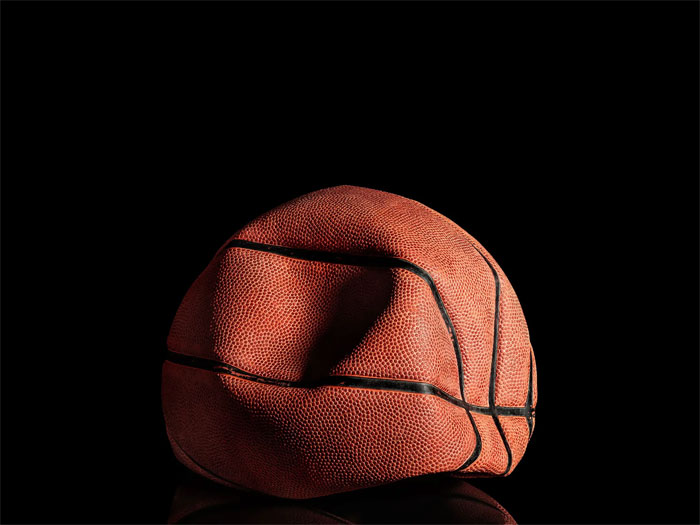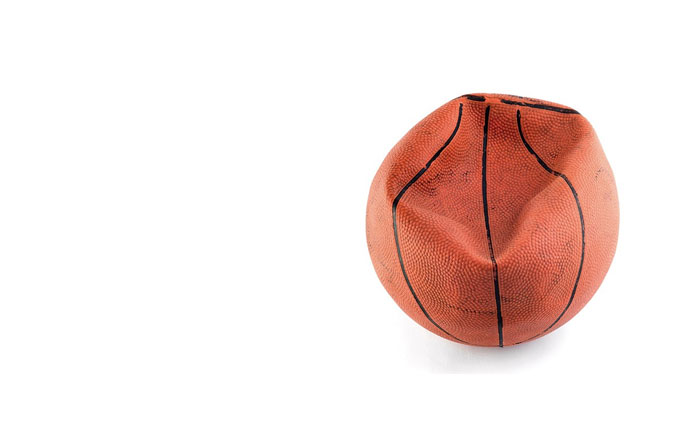It's pretty common to wonder how to inflate a basketball, but what if you need to do the opposite? Information on how to deflate a basketball isn't so easy to come by.
Can you deflate a basketball safely? Why would you need to? If you find yourself in a situation where you need to let some air out of your basketball, we've got you covered.
This guide will take you through the process of how to deflate a basketball step-by-step. We'll cover times when you might need to do this and answer common questions about the process.
Let's get to it.
When Do You Need to Deflate A Basketball?
There aren't many occasions that call for letting air out of a basketball. The 2 major reasons you might need to do this are overinflation and storage/transport. Let's take a look at how these work.

Overinflation
Most people reading this will share a common problem: their basketball is bouncing too high. Maybe you've just pumped it up, or perhaps it's a new ball.
When the ball bounces too high it's difficult to control. NBA rules dictate that a ball must contain 7.5-8.5lbs of pressure. This level of pressure is considered ideal for a controlled bounce and smooth play.
You can check the pressure on your ball with a pressure gauge, but chances are you'll know it's overinflated just by bouncing it.
Pressure leaves the ball naturally over time, but this is a very slow process. In these cases, you might want to consider deflating your basketball.
Storage and Transport
Another reason you may need to deflate your basketball is that you need to store or transport it.
Anyone who has ever moved house knows the ritual of packing everything up as small as possible. You roll up clothes, take the furniture to pieces, and… deflate your basketball? It adds up.
Likewise, if you're storing your basketball somewhere and are unlikely to use it for a while, you might consider deflating it. This is usually fine for a run-of-the-mill rubber basketball, but if the ball is precious to you, you might want to think twice.
Deflating a high-quality basketball can have unexpected consequences.
Does Deflating a Basketball Damage It?
Deflating a leather or synthetic basketball can potentially be damaging to the ball. Full deflation can lead to the panels separating in some cases. This isn't common and is usually a consequence of deflating the ball too quickly, but it's worth bearing in mind.
We imagine that you probably won't want to fully deflate your high-quality leather basketball for storage or transport. After all, leather balls are the best — science says so! It's worth a few extra inches of space in the van.
However, if for any reason you need to fully deflate a leather or synthetic ball, make sure you do it slowly and carefully. Otherwise, you could risk damaging your prized possession.
Note that rubber balls are always safe to deflate.

Deflating a Basketball Without a Needle
The other way you can damage a basketball when deflating it is by using improvised equipment, such as a hairpin or safety pin.
This can work but remember you're essentially picking the basketball's lock by doing this. By using equipment that wasn't designed for this purpose, you can damage the ball's pressure valve.
Always use a proper inflation needle to ensure that you don't cause lasting damage. They're cheap and easy to find, so there's rarely a good reason for deflating a basketball without a needle.
Is it Dangerous to Deflate a Basketball?
It's extremely unlikely that a basketball will ‘explode’ when deflating. The regular air pressure in a basketball is high, but the air will escape gradually rather than cause the ball to explode like a cartoon bomb. This would only happen if you massively overinflated the ball.
Even stabbing a ball tends to produce underwhelming effects. If you're using an inflation needle, there's virtually no chance of anything happening.
Equipment for Deflating a Basketball
You can use 2 different items to deflate a basketball. Most of us will just use an inflation needle, but in the spirit of being professional, you should have either:
Inflation Needle
If you need to let some air out of your ball because you've overinflated it, good news! The inflation needle you used can also be used to deflate the ball.
This is the most essential piece of equipment for deflating. Inflation needles can be found at almost all sports stores or bought online. They're relatively inexpensive, so put away that safety pin and get yourself one.
Pressure Gauge
A pressure gauge allows you to see exactly how much air is in the ball. It can be used in place of an inflation needle to release pressure.
If you're looking to get your ball within that 7.5-8.5lbs range, this is the best way to achieve a precise level of pressure.
It's not essential to use a pressure gauge, but it can also help you to know what level of pressure you prefer in a basketball.
Try bouncing it at different pressure levels and see what suits you. This can help you adjust any basketballs you might buy in the future to the perfect level.
How to Deflate a Basketball — Step-by-Step Guide
Here's an easy and straightforward guide on how to deflate a basketball.
1. Check Pressure
How much pressure do you want to release? Bounce the ball to determine how much air needs to be let out.
If you're using a pressure gauge, don't insert it yet! We're going by feel at this point.
2. Moisten the Needle
The pressure gauge will have a needle similar to the inflation needle.
Whichever method you're using, this needle needs to be lightly moistened using water. This helps it to slide smoothly in and minimizes the risk of damage to the pressure valve.
3. Insert the Needle into the Pressure Valve
Simple slide the needle into the center of the pressure valve.
If you're using a pressure gauge, you can check the gauge at this point to see how much air is in your ball.
4. Release Air
If you're using an inflation needle, air will begin to leave the ball at this point. For those using a pressure gauge, gently push down the button on the pressure gauge to release air.
Don't leave the inflation needle in too long. You can always try again if the ball is still too full! Remove the needle once you think enough air has left the ball.
When the pressure gauge reaches the air pressure you're looking for, simply release the button and remove the needle of the gauge from the basketball.
If you're fully deflating your basketball, you may want to press on the outside of the ball to allow air to release faster.
Remember that this is safe for rubber balls, but if you're fully deflating a leather or synthetic ball, it's better to take longer and avoid damaging the ball.
5. Test Drive
Take your ball outside and see how it feels. If it's still bouncing too high, don't worry! You can repeat the process — just remember to wet the needle before re-inserting it.
It's common to ‘not deflate enough’ if you've not done this before. We worry about our ball going flat, but the release of air is fairly slow.
If you want to avoid repeat deflations using trial and error, you may want to invest in a pressure gauge.
Once you're satisfied with the feel of your basketball, that's it! You're all done, and you have successfully deflated your basketball.
Conclusion: How to Deflate a Basketball
Deflating a basketball isn't something you need to every day. It may not be something you ever need to do. But hey, it's good to know how to do it if the need ever arises.
The main takeaway is that it's worth having an inflation needle around at the very least. We hope this guide has helped you understand how to deflate a basketball safely and easily!

